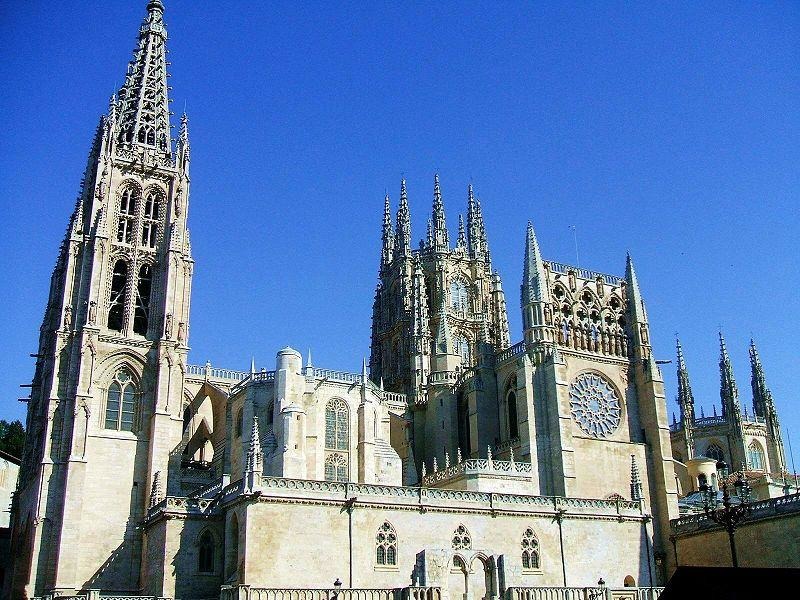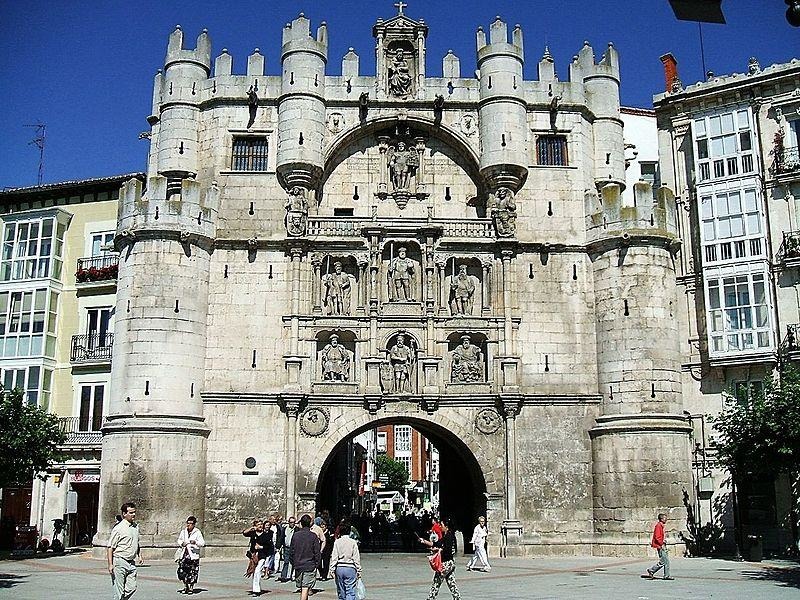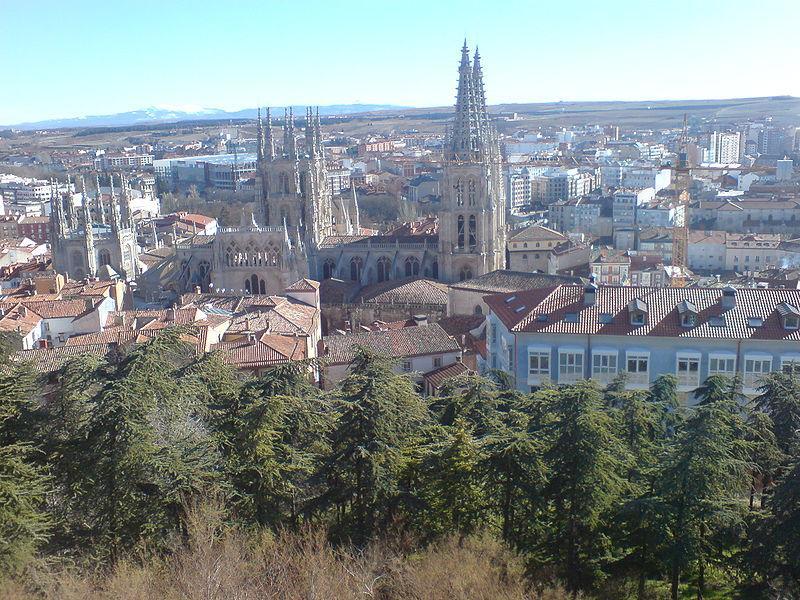Burgos, Castela e Leão, Spain
Suggest Place to Visit
3660
Track to location with GPS |
 |
Pre-Roman settlements existed in the area, of which there are samples on the hill of the castle from the Neolithic period, about 4500 years BC. C. and of the first Age of the Iron, near 850 years a. In an Arab chronicle a population sacked in the year 860 called Burchia is mentioned, which seems to correspond with the current Burgos.
Around 884, Alfonso III, trying to stop the Muslim advance, sent Diego Porcelos to build a fortification on a hill on the right bank of the Arlanzón River. This would help the place to grow due to its strategic importance.
In 931, Fernán González managed to reunite the government of the counties of Burgos, Lara, Lantarón, Cerezo and Álava, [6] leaving Burgos as the capital of the county of Castilla.
When in 1038 Ferdinand I was crowned King of León, forming the kingdom of Castile, Burgos was chosen as his capital.
In 1071 Sancho II imprisoned his brother García in Burgos to take the kingdom of Galicia from him. In 1074 Alfonso VI, king after the death of his brother Sancho, gave his palace in Burgos for the construction of the Cathedral of Santa María. That same year his sisters, Elvira and Urraca, moved the diocese from Oca to Gamonal.
After the conquest of Toledo in 1085 by Alfonso VI, Burgos lost the capital of the Kingdom of Castile, in favor of this city. This did not paralyze the growth of Burgos, where some Cortes would continue to be held.
Formation in Burgos of the First National Government of Spain (1938-1939), Francisco Franco officially assumed the positions of Head of State and Government. During the period between April 1 and October 18, 1939, at the end of the Spanish Civil War, the city of Burgos was the capital of Spain.
Burgos was born from the small buildings that were emerging around the slopes of the Castle, so the oldest areas of the city are between this hill and the Arlanzón river.
At the beginning of the 20th century, the Ensanche began. Large avenues were created, which today distribute a large part of the city's traffic. Plaza España can be considered as the nerve center, since the Avenida de la Paz, Avenida del Cid and Avenida de Reyes Católicos start from it. It is also the main stop of many urban bus lines, distributed around the dolphin roundabout.
In 1970 the tallest residential building in the city, the Feygon, was built. It has 16 floors and a little over 70 meters, just behind the Cathedral, which is still the tallest building, exceeding 80 meters with its spiers. It was not until 1978 when more buildings of those heights, the so-called ‘Carrero Blanco’ towers, were built in the Vena area. Towers are being planned in the surroundings of the future city of the AVE, which will reach up to 25 floors. Also in the surroundings of the old station there is a 20-storey tower.
Declaration of the development and annexation pole of Gamonal. Developmentalism and spectacular population growth. C / Vitoria is one of the longest in the city, reaching 3.5 km, connecting Gamonal with the center. It will be widely surpassed by the Boulevard, reaching 12 km.
Rail diversion. To the north of the city.
New projects, such as Bulevar, AVE city, Villímar.
In 2010, the urbanization works of the new transversal axis of the city began, the so-called Avenida de Valencia, which with its more than 12km in length, will run along the old train route as it passes through the city. It will represent the largest urban transformation suffered by the city in its history, and will unite the north with the south, creating car parks, green areas, and dedicated public transport lanes in its path.
Burgos is a municipality and a Spanish city located in the north of the Iberian Peninsula, capital of the province of the same name and of the old historical region of Castilla la Vieja, in the autonomous community of Castilla y León. According to demographic data for 2009, it has a population of 178,966 inhabitants, spread over an area of 107.08 km², making it the 37th most populated city in Spain, and the second in the community, behind Valladolid. [2]
There is evidence of settlements in the Cerro del Castillo that dominates the city in the Neolithic and in the first Iron Age, however, the city of Burgos was founded as such by the Asturian count Diego Rodríguez ´´Porcelos´´ in 884 Around 930, it became the capital of the county of Castilla when it reached its independence from the kingdom of León under the leadership of Fernán González. It was the capital of the Crown of Castile intermittently, from 1230 until the reign of the Catholic Monarchs. In 1512, the Laws of Burgos were enacted in the city, the first laws that the Hispanic Monarchy applied in America to organize its conquest.
It has a green ring and a vast monumental complex, among which the Cathedral of Santa María, an example of Gothic architecture declared a World Heritage Site, the monastery of Santa María la Real de Las Huelgas and the Carthusian monastery of Miraflores stand out. In addition, the city is crossed by the Camino de Santiago, and is only 15 km from the archaeological site of Atapuerca.
The city experienced strong industrialization during the 20th century, mainly around the automotive and food sector, caused by good communications with other capitals, such as Valladolid or Vitoria, which are only about 120 km away. These factors, together with a developed tertiary sector, with a notable presence of tourism, make it the 18th city in economic activity in the nation.
It houses the headquarters of the Superior Court of Justice of Castilla y León and the Castilian and Leonese Institute of Language. In 2010 its City Council was governed by the Popular Party, with Juan Carlos Aparicio being mayor.
Burgos is one of the candidate cities to be the European Capital of Culture in 2016. In addition, it is the venue for several national events, such as the Electrosonic electronic music festival, or the ForoBurgos conferences, around the economic and business.
In recent years, the city has experienced a significant boom in the research sector, with centers such as CENIEH, the Burgos Research Area, CREER and ITCL, among others.
The city of Burgos is located in the center of the province of Burgos, 244 km north of Madrid, in the autonomous community of Castilla y León (Spain). The coordinates of the city are latitude 42º 20´ 57.1´´ N and longitude: 3º 41´ 4.7´´ W, it has an area of 107.08 km² and is 856 meters above sea level according to the National Geographic Institute. Its privileged location, approximately in the center of the north of the peninsula, places it as a city of obligatory passage from the plateau towards the Basque Country and France, in addition to being the starting point of two of the main accesses to Cantabria.
View of the Arlanzón river as it passes through the city.
Hydrography [edit]
The town is crossed by the Arlanzón river, which divides the city into two areas that are well differentiated by its historical age, since the old town is located on the right bank. Other rivers pass through the municipal area, such as the Vena (which flows into the Arlanzón near the historic center), the Cardeñadijo and the Ubierna, tributaries of the Arlanzón and the Pico river, a tributary of the Vena.
Weather
Burgos's climate is continentalized Mediterranean or moderate continental with Mediterranean influences on the rainfall regime. The rainiest season is spring while summer is mild and much less humid than in Atlantic Spain. Winters are very snowy and cold with minimum temperatures that sometimes drop below -10 ° C. Heavy snowfalls are frequent per season, lasting even well into spring.
Places of interest
Cathedral of Santa María La Mayor in Burgos
It is the most representative building in the city. Its construction began in 1221 following French Gothic patterns and concluded in 1260. It had major modifications in the 15th and 16th centuries (spiers of the main façade, the Constable's chapel, the transept dome: these elements of advanced Gothic give the temple its profile unmistakable). Among its visitors the clock of the Flycatcher is very popular for unusual. It was declared in 1984 a World Heritage Site by UNESCO.
Monastery of Santa María la Real de Las Huelgas
It is a Cistercian monastery founded in 1189 by King Alfonso VIII of Castile. It is part of the National Heritage.
Charterhouse of Santa María de Miraflores
Monastic complex built about three kilometers from the city of Burgos itself. It was founded in 1441 by King Juan II of Castile, thanks to the donation that the monarch himself made of a hunting palace to the Carthusian Order, where they settled until a fire in 1452 caused the destruction of the building. In 1453 it was decided to build the complex that has survived to this day, conceived to be the grave of the parents of Isabel la Católica.
Church of San Gil Abad
Gothic in style, its greatest interest lies in the collection of late Gothic altarpieces carved by Gil de Siloé and Juan de Vallejo.
Church of San Esteban
Gothic in style, the current temple was built on an old Roman temple at the end of the 13th century and during the first half of the 14th century.
Church of La Merced
Late Gothic monument from the 15th and 16th centuries located on Calle de la Merced. Today it continues to have a religious use as a parish of the Jesuit Fathers, while the old conventual dependencies, inhabited by the Mercedarians for more than three centuries, are today integrated into a hotel business.
Church of San Lorenzo
Baroque, late 17th century. Previously it belonged to the Jesuits.
Civil architecture
Arch of Santa Maria
It is one of the most emblematic monuments of Burgos. It is one of the old twelve access gates to the city in the Middle Ages, rebuilt as an arch in honor of Carlos I. It connects the Santa María bridge, over the Arlanzón river, with the Plaza de San Fernando, where it stands Cathedral.
Burgos Castle
It is located on the hill of its name raised 75 m above the level of the city. Raised by Count Diego Porcelos in the days of the Reconquest, in the year 884.
King's Hospital
Located next to the Camino de Santiago as it passes through Burgos, it was founded by Alfonso VIII in 1195. Dependent on the Monastery of Santa María la Real de Las Huelgas, it was a great reception center for pilgrims.
Palace of Captaincy General
It served as a military base during the uprising of the civil war. Since him, Franco was declared Superior Chief of the Armies of Spain.
Palace of the Provincial Council of Burgos
It houses the headquarters of said government. It is a neoclassical building dating from the early 20th century. Its restoration was completed in 2008.
Houses of Miranda and De Íñigo Angulo
In its dependencies is the provincial museum, the old Archaeological Museum, which is built in two adjoining 16th century palaces. The patio of Casa de Miranda with supported galleries stands out.
Palace of the Constables of Castile
Also known as the Casa del Cordón, it is an old Renaissance palace dating from the 15th century that stands in the historic center of Burgos. Its promoter was the Constable of Castile Don Pedro Fernández de Velasco. The initial design is attributable to Juan de Colonia and his son Simón and it is a late Gothic civil building. As evidenced by an inscription on its facade, the building received Christopher Columbus after his second trip to the Americas.
Island Palace
It was the residence of the Head of State during the civil war from 1936 to 1939. It has had numerous functions until it became the official headquarters of the Institute of the Language of Castilla y León. From him the order was given to terminate the Civil War. It also has the first elevator that was installed in the Community.
Burgos Railway Station
It was ordered to be built in 1901 by the Norte company, which replaced the provisional station, which had been in operation for 40 years, since the arrival of the railway in the city on October 25, 1860. The company commissioned the design of the work Franco-Spanish civil engineer Enrique Grasset y Echevarría. Just a year later, the passenger building was inaugurated, which, as in most North stations, was made up of three different parts: the central pavilion with a lobby, ticket sales and some offices; a left side section, with waiting rooms and a post office (although later another building would be built for the postal service); and a right side section, with a luggage room, a canteen and some offices for drivers, security guards or North personnel. The building, measuring just over 92 meters, is made of stone and brick, with a flat black tile roof. It no longer receives the trains, since in 2008 the circulation was diverted to the north, and the current station was built. Currently, it is in the process of rehabilitation, to constitute the City of Arts in the city in the near future.
Plaza del Cid
Square located in front of the Principal Theater, between Vitoria Street and San Pablo Bridge. In the center stands a bronze figure of the Cid Campeador, built around 1960.
San Pablo Bridge
Bridge built in stone that connects the southern part of the city with the Plaza del Cid. It is adorned with different sculptures related to the life of the Campeador.
Espolón Walk
It is the most central and popular wooded and landscaped promenade of all the parks in Burgos. It arose at the end of the 18th century and was configured during the 19th century. It connects the Arch of Santa María with the Main Theater and is considered ´´the hall´´ of the city.
Island Walk
This walk, located on the banks of the Arlanzón River, on an island between the river and the city canals, is considered a true botanical garden.
Minor Market Square
Commonly known as the Plaza Mayor. It is a construction in the shape of an irregular perimeter, located adjacent to the Paseo del Espolón, in the heart of the old town. First called the weekly market square, granted by the kings Fernando el Católico and Carlos I, it became the largest center of commercial activity in Burgos. In it the Puerta de las Carretas was opened, through which the cars entered the markets that supplied the city and the stalls were distributed around it, under the arcades that surround the square.
Comments
We don´t have yet any comments about:
Burgos
Burgos
Be the first to leave a comment as it is very important to inform other people
Outros locais a visitar
Within a radius of 20 km from:Burgos
Burgos Cathedral |
| 0,5 Km |
 |
Arch of Santa Maria (Burgos) |
| 0,6 Km |
 |
Hotel reservation near Burgos within a radius of 20 km
Why to book with BOOK HOTEL ALGARVE
The best prices
Our partnerships with the world´s largest operators offer research on the best market prices.
More options
At Rotas Turisticos you can book the hotel, buy the air ticket, book the transfer from the airport to the hotel and vice versa, book the local excursions, rent the car, take travel insurance and consult the places to visit and where to go.
Holiday Tips & Destinations
Hundreds of holiday destinations with all the options that allow you to easily choose the destination that best suits your dream vacation.
BOOK HOTEL ALGARVE
Links






